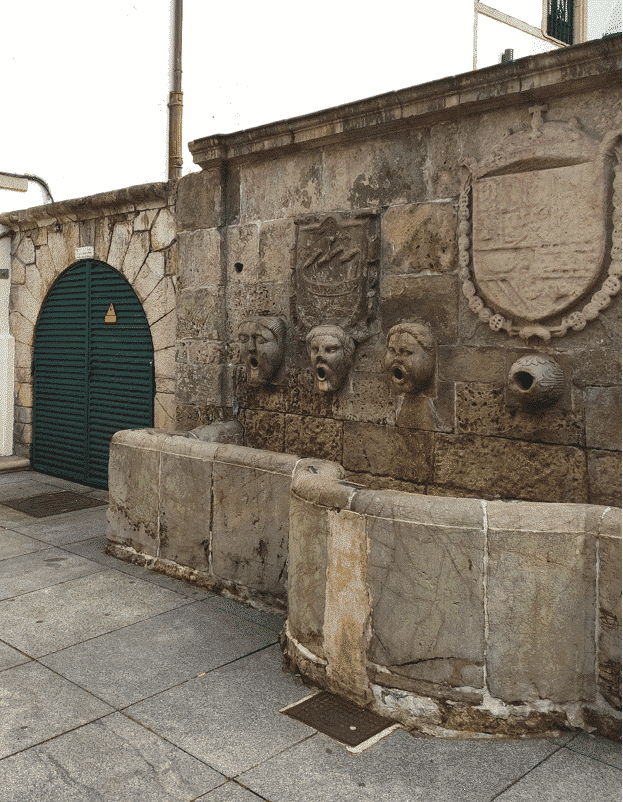Welcome to the enchanting city of Avilés, located in the heart of Asturias, Spain. This historic city is home to many architectural gems and cultural treasures that are sure to captivate any visitor. Among these attractions stands one particularly charming monument – Fuente de los Caños de San Francisco.
Overview
The Fuente de los Caños de San Francisco, or Fountain of St. Francis’ Spouts in English, is a historically significant fountain situated in Plaza Carbayo near the Church of Saint Nicholas of Bari. It’s an iconic symbol representing the rich history and culture of Avilés and has been a gathering spot for locals over centuries.
Historical Significance
Built during the 16th century as part of an urban expansion project by Pedro Solís y Valdés – a nobleman from Aviles who served Charles V, Holy Roman Emperor – this public fountain was initially designed to supply water for domestic use to local inhabitants. Over time it became more than just a utilitarian structure; it transformed into a social hub where people would gather around its spouts while collecting water or washing clothes.
Architectural Splendor
The architecture reflects Renaissance aesthetics with some Mannerist influences evident in its design elements such as pilasters and friezes featuring floral motifs. The most striking feature about this fountain is undoubtedly its eight bronze spouts shaped like human faces which were cast at Seville’s Royal Artillery Factory under King Carlos III’s reign (1759-1788). These expressive faces have become synonymous with Fuente de los Caños de San Francisco itself!
A Symbolic Structure
This beautiful piece not only serves as an aesthetic delight but also holds symbolic importance reflecting Spanish society during those times. The eight bronze faces represent the different social classes that existed in Spain during the 16th century, making it a significant historical and cultural monument. While some faces are adorned with crowns symbolizing nobility, others depict common folk or even slaves.
Renovations
The Fuente de los Caños de San Francisco has undergone several restorations over its long history to preserve its original charm while ensuring functionality. One of the most notable renovations took place in 1781 under King Carlos III’s reign when new pipes were installed and the fountain was embellished with eight new spouts cast at Seville’s Royal Artillery Factory.
Present Day Status
Today, this iconic fountain continues to be a popular attraction for both locals and tourists alike who appreciate its historic significance and architectural beauty. It’s not just an impressive sight but also serves as a reminder of Avilés’ rich past. Even though it no longer provides water for domestic use, it still stands proudly as one of Aviles’ most cherished landmarks.
A Must-Visit Attraction
If you’re planning a trip to Asturias, make sure you include Fuente de los Caños de San Francisco on your itinerary. This beautiful piece of history is definitely worth visiting not only for its aesthetic appeal but also because it offers visitors an opportunity to delve into Spain’s fascinating past. And while you’re there, don’t forget to explore other attractions around Plaza Carbayo such as Church of Saint Nicholas of Bari or take a leisurely stroll through this charming city soaking up all that Avilés has to offer!
Frequently asked questions
What is the Fuente de los Caños de San Francisco in Avilés?
The Fuente de los Caños de San Francisco, often shortened to simply “Los Caños,” is a historic fountain located in the town of Avilés, within the Asturias region of northern Spain. The fountain dates back to the 16th century and features an intricate design that reflects both Renaissance and Baroque architectural styles. It has been an iconic landmark in Avilés due to its historical significance and artistic value.
Where exactly is the Fuente de los Caños de San Francisco situated?
The Fuente de los Caños de San Francisco is located at Plaza Pedro Menéndez, right next to another notable site – Church of Saint Nicholas of Bari (Iglesia de Santo Tomás). This location places it near many other cultural attractions within Avilés’ old town district, making it a convenient stop for those exploring this charming Spanish city.
Can visitors interact with or drink from Los Caños?
No, visitors are not allowed to drink from or touch the water spouting from Los Caños. Due to its age and historical importance, efforts have been made by local authorities to preserve this monument’s integrity. As such, touching or interacting with it beyond viewing could potentially damage its structure over time.
When can I visit Fuente de los Caños de San Francisco?
Bearing in mind that it’s an outdoor public monument without specific opening hours like museums or galleries might have; you can visit any time you want. However, visiting during daylight hours would offer better visibility for appreciating details on this impressive work of art.
What else should I know about Los Cãnos before my visit?
While the Fuente de los Caños de San Francisco is a free-standing monument that can be appreciated at any time, it’s worth noting that its history and significance are deeply tied to Avilés’ cultural fabric. The fountain was originally built as part of an effort to provide clean drinking water for the city’s inhabitants during the 16th century. Today, it remains a symbol of Avilés’ rich past and dedication to public works. As such, appreciating Los Cãnos means not only taking in its aesthetic beauty but also understanding its place within local history.












